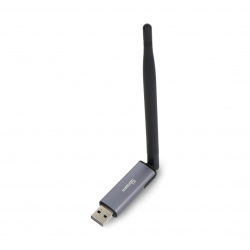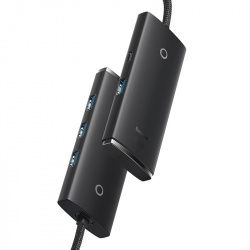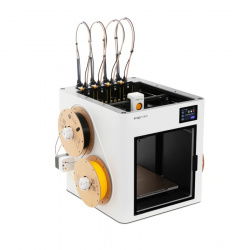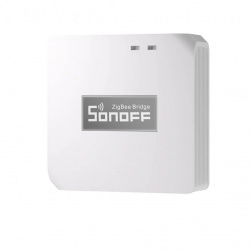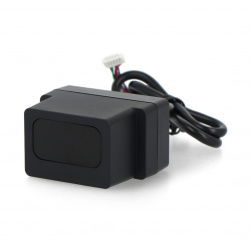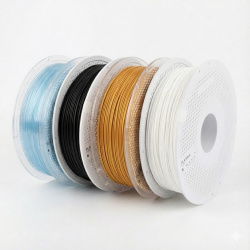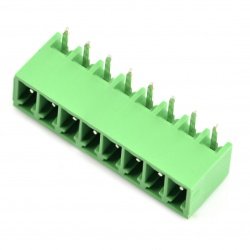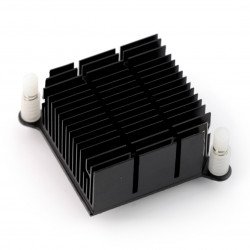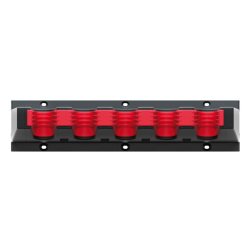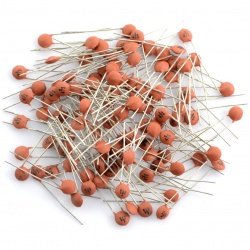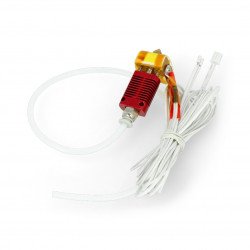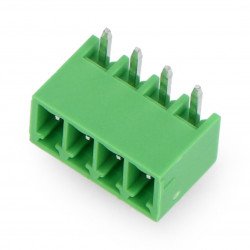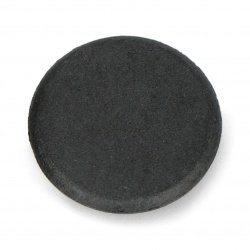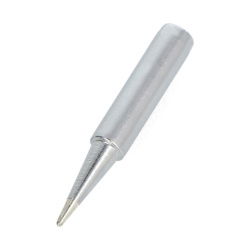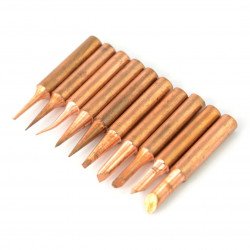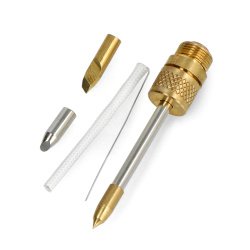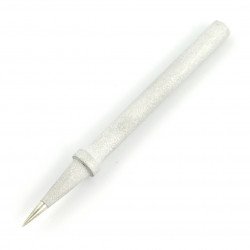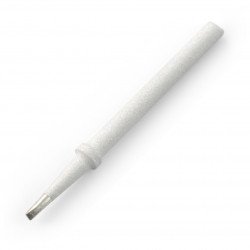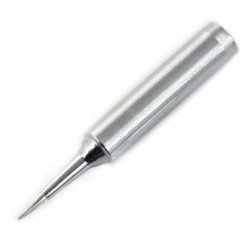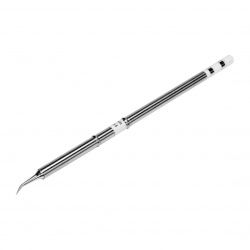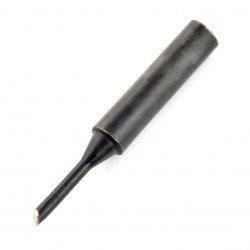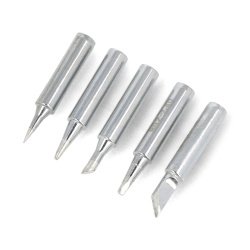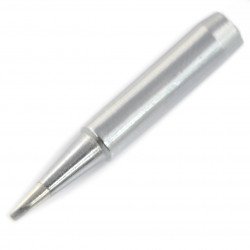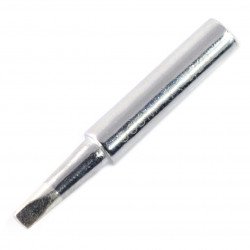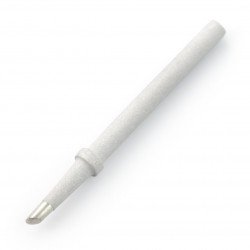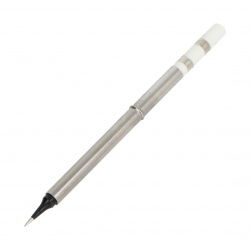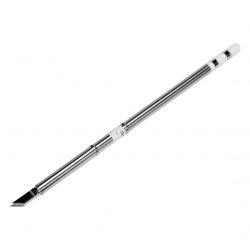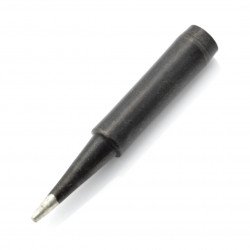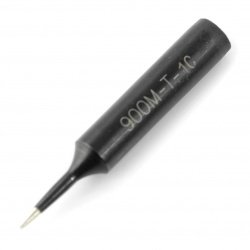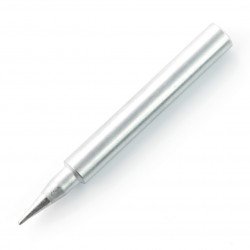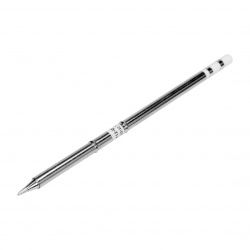Soldering is the most important step in the assembling of electronic devices. Of done February must have smoothness, Shine and durability, so how does this affect the correctness and reliability of the installed equipment. Outside the same skill with a soldering iron, important proper selection of the binder rations, but also auxiliary equipment and accessories. In order to obtain the best soldering results, the correct selection of the grotto soldering iron of suitable size and shape.
Soldering tips
Set of tips for soldering stations - 900M series - 10 pcs.
A set of soldering tips for soldering station from series Black T, works i.a. with stations: 936, 937, 803, 738, 995da+, etc.Set of copper tips for soldering stations - Copper series 900M - 10pcs
Set of copper soldering tips for soldering station series Copper, work with stations: 936, 937, 803, 738, 995da+, etc.Soldering tip for station type 79-3111 ZD99
Soldering station tip type 79-3111, works with stations such as: ZD99, SL98, etc.Set of tips for FlatPro2 soldering iron - Webski SOLDGROT01
The FlatPro2 soldering iron tip set is a universal set containing three replaceable tips and a spare resistance insert, ideal for precise soldering work. It is compatible with...Tip for soldering station type 79-3121 ZD99
Tip for soldering station type 79-3121, cooperates with, among others, stations: ZD99, SL98, etc.Soldering tip for soldering station type C1-4 79-3141 ZD99
Soldering tip for solder station type 79-3141 cooperates, among others, with stations: ZD99, SL98, etc.Tip for soldering station - type T-I
Tip for soldering station type T-I, it works, among others, with stations: 936, 937, 803, 968, 995 etc.Soldering station tip type T12-JL02 with integrated heater - Yato YT-82492
The T12-JL02 soldering tip is a specialist tip designed for precise service and assembly work in electronics. Equipped with an integrated heater and temperature sensor , it...Soldering tip - type T-2CF HQ - Black
Blade for soldering stations Black type 900M T-2CF HQ series, works with stations, among others: 936, 937, 803, 968, 995 etc.- Reduced price
- SPECIAL OFFERS
Soldering station tip set - 902M-T series - 5pcs.
A set of 5 tips for soldering stations , series 902M-T, ensures comfort and precision during soldering. The kit includes various types of tips such as conical, chisel,...Soldering iron tip - bevel type T-1.6D
Bevel tip for soldering station type T-1.6D, it works, among others, with stations: 936, 937, 803, 968, 995 etc.Soldering iron tip - bevel type T-1CF
Soldering station tip bevelled type T-1CF, works with stations such as: 936, 937, 803, 968, 995 etc.Soldering tip - type 900M T-3.2D
Tip for soldering station bevel type 900M-T-0,8 D, it works, among others, with stations: 936, 937, 803, 968, 909 etc.Soldering tip for soldering station type C1-3 79-3131 ZD99
Soldering tip for solder station type 79-3141 cooperates, among others, with stations: ZD99, SL98, etc.JT-SI01-STK65 blade-shaped soldering iron for the Joy-IT JT-SI01 cob soldering iron
A high -quality, blade-shaped soldering tip designed specifically for the JT-SI01 soldering iron . The shape allows for precise solder application to larger surfaces and...JT-SI01-STILS_01 conical-shaped 0,3mm soldering iron tip for Joy-IT JT-SI01 flask soldering irons
High -quality, cone-shaped soldering tip , designed specifically for the JT-SI01 soldering iron. The shape enables precise tin application and efficient removal of excess...JT-SI01- STB2 tapered 0,8mm soldering tip for Joy-IT JT-SI01 flask soldering iron
High -quality, replaceable, cone-shaped soldering tip , designed specifically for the JT-SI01 soldering iron. The shape allows for precise tin application and efficient...Soldering station tip type T12-K with built-in heater - Yato YT-82491
The T12-K soldering tip by Yato is a precision soldering tip with a built-in heater and temperature sensor . Designed for YT-82461, YT-82462 and YT-82490 soldering stations,...Soldering station tip type T12-ILS with built-in heater - Yato YT-82495
The T12-ILS soldering tip is a specialist tip designed for precise service and assembly work in electronics. Equipped with an integrated heater and temperature sensor , it...Soldering station tip type T12-B2 with built-in heater - Yato YT-82498
The T12-B2 soldering tip is a specialist tip designed for precise service and assembly work in electronics. Equipped with an integrated heater and temperature sensor , it...Tip for soldering station - series Black type 900M T-1,6D HQ
Tip for soldering station series Black T-1.6D, it works, among others, with stations: 936, 937, 803, 968, 995 etc.Soldering tip for soldering station - series Black type 900M -T-1C
Tip for soldering station series Black type 900M-T-1C, it cooperates, among others, with stations: 936D, 898D, 852, 936, 738, etc.Soldering station tip type T12-D16 with built-in heater - Yato YT-82494
The T12-D16 soldering tip is a specialist tip designed for precise service and assembly work in electronics. Equipped with an integrated heater and temperature sensor , it...See also
Selection of a soldering tip
The purpose of the soldering tip is to transfer heat from the soldering iron to the area to be soldered. In simple terms, it is best to choose a tip that will allow you to deliver high enough temperature in the shortest amount of time to complete the soldering in the shortest time possible without exposing the PCB and the components on it to damage due to too much heat over time.
Conical tips for soldering stations
In real conditions, you can often deal with very small elements on PCBs, where the use of a large soldering tip is very troublesome - in this case, it is worth paying attention to its geometry. A tip cut on one side at an angle of 45 or 60 degrees significantly facilitates access to the tightest places in electrical circuits, but conical tips and rounded tips will also be helpful when soldering in small areas. The truncated cone shape of the tip is one of the most popular among professionals and DIY enthusiasts.
Soldering iron tips for more demanding tasks
When soldering electromagnetic screens and disassembling electronic components, a sharp tip will be helpful, as its sharp edge allows access to areas where a large, traditional soldering tip cannot be used. When soldering surface-mounted components (SMD), it is best to use a mini-wave tip, the shape of which makes it easier to solder multiple pads (in the case of e.g. SMD integrated circuits) with a single pass of the solder, and also enables the removal of excess solder causing undesirable short circuits between the soldering points. If a large number of short circuits occurred during assembly, it is best to use a non-wettable needle tip with a reduced tendency to stick to the soldered surfaces.
How to care for soldering tips?
One of the factors affecting the life of the tip is the use of high-quality solder . Low-quality solder may contain impurities that, when deposited on the surface of the soldering tip, may worsen its thermal conductivity and make the soldering process more difficult. A good soldering filler should melt within a short time of applying a heated tip to it. For example, containing 60% tin and 40% lead (see also: Tins and solder pastes), it should melt easily at a temperature of 240°C. When metals come into contact with air, they may oxidize, and this also applies to soldering tips. To prevent this, use fluxes, wet sponges and brass cleaners to clean soldering residue. Our offer includes tips for heater soldering irons, transformer soldering irons and gas soldering irons. We also offer a set of arrowheads containing a different number and type of arrowheads.
Caverns - FAQ
The tip is a special metal working tip that enables effective heat transfer to the soldered elements. In the case of soldering irons, it most often takes the form of an elongated cone with a mounting sleeve, and if we are dealing with a transformer soldering iron, the tip is made of an appropriately formed copper wire.
In the case of popular soldering irons, we have a wide selection of tips in various shapes and sizes. The general rule is that the tip size of the tip should correspond to the dimensions of the elements to be soldered - tips with a diameter of about 1.0..1.5 mm are usually suitable for assembling THT technology boards, while small SMD components require sharp cones of about 0. 5mm.






























































































































































































































































































































